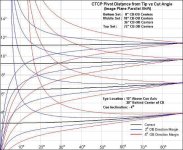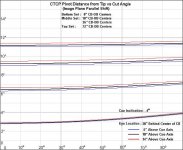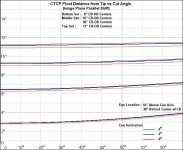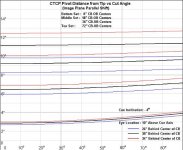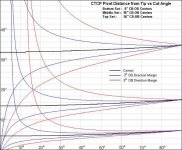LAMas,
Excellent description. FYI, I've added it, along with your diagram showing examples, to my CTE resource page. Please check it out and let me know if any changes are appropriate.
Thank you for setting a good example of how an aiming system can be described and illustrated clearly, concisely, completely, and with full disclosure (i.e., honestly).
Regards,
Dave
Excellent description. FYI, I've added it, along with your diagram showing examples, to my CTE resource page. Please check it out and let me know if any changes are appropriate.
Thank you for setting a good example of how an aiming system can be described and illustrated clearly, concisely, completely, and with full disclosure (i.e., honestly).
Regards,
Dave
Hi,
This is for shots from 1 degree to 29 degrees. For shots from 31 degrees to 90 degrees it doesn't work...more study is required.
What I like about CTE having tried it and wanting to make it work for me.
I can discern the Center of the CB and the Edge of the OB and the contact point on the OB that sends the OB to the target/pocket.
I can aim the center of the CB at the edge on the equator (3 o’clock or 9 o’clock) of the OB that is on the side opposite the target/pocket – CTE[Line].
I can find the contact/impact point on the equator of the OB that sends the OB to the target/pocket. I concentrate on the distance from that point to the original edge, and then I parallel shift the cue until it is shifted that distance away from the edge of the OB.
I then pivot back from my bridge until the tip of the cue is aimed at the center of the CB and then I shoot the shot. This gets me close to where the ghost ball should be. English can be applied pre shot if desired.
I use double distance aiming though for it has fewer steps – no pivot. I think that CTE is helpful to those that miscalculate where the center of the OB is - which is necessary for double distance aiming.
As the OB appears to get smaller as it is located farther away from the CB and the shooter’s eye/s, the distances from the edge of the OB and the contact point gets smaller and thus the outward shift is proportionately smaller which allows the “system” to adjust for the for-shortening/perspective and still sends the CB to where the GB should be.
The bridge is what you are comfortable with, say 12.0” or so behind the CB – no change necessary.
Try it, you might like it.
Thanks for your time….wasted?
:smile::thumbup:
